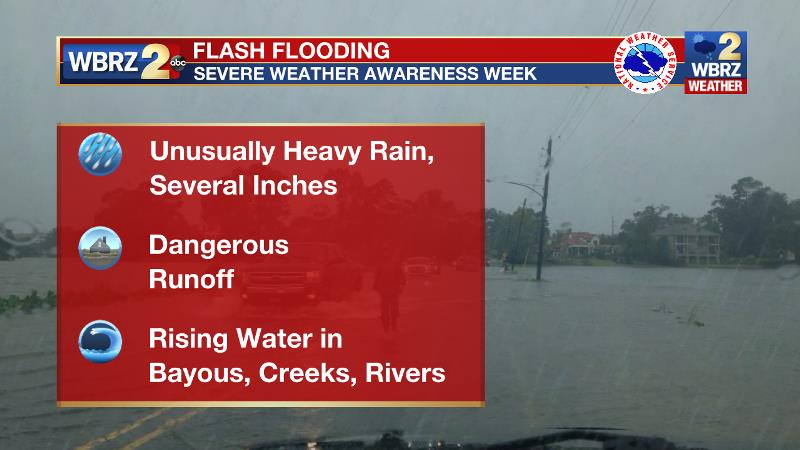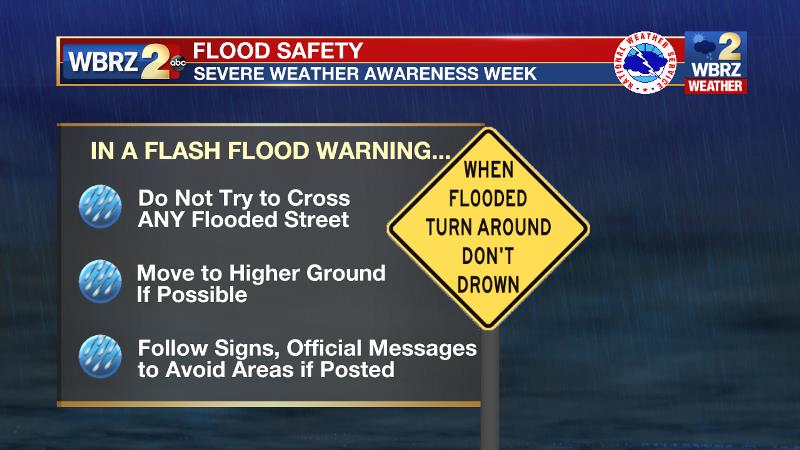What you should know: flooding
A Flash Flood Warning is issued when the National Weather Service detects an unusually high amount of rain that could lead to rising creeks, streams, rivers and dangerous runoff. A Flash Flood Emergency means extremely heavy rainfall has already occurred will continue to occur, and emergency officials are reporting rises in water that are resulting in water rescues or evacuations.

Flash flooding is a result of sudden, heavy rainfall commonly produced from slow-moving intense thunderstorms or multiple rounds of thunderstorms occurring over the same area. Flash flooding can also occur with a dam or levee failure. Flash floods become raging torrents of water which rip through creek beds, city streets, and areas of poor drainage, sweeping away everything before them. Over the last 30 years, on average, flash flooding kills more people each year than any other weather phenomenon. Stats from around the U.S. show about 85 fatalities per year due to flooding.
Almost half of all flash flooding deaths occur in vehicles. You’ve heard it before, “turn around, don’t drown!” Two-feet of moving water can move most vehicles including pick-up trucks. Once water reaches your car door, it is close enough to enter the exhaust pipe or engine, stalling you out and causing serious damage. So, “hit the brakes y’all, don’t stall!” And just a few inches of moving water can knock a strong adult off of their feet.
So if a flash flood warning is issued, do not try to cross any street where the water depth is unknown – even if it is a road you travel each day, there is no telling what lies beneath. Move to higher ground and if officials ask you to move from or avoid certain areas, listen to them!

Determine your risk of flash flooding by knowing your proximity to streams. Densely populated areas are at a greater risk for flash flooding because pavement and concrete increases runoff. Less water being absorbed by the ground means there is more water available to overwhelm storm drains and flood low-lying areas.
Trending News
For outdoor enthusiasts, it is important to be aware of rain potential before you head out—especially if fishing or camping near a body of water. A creek that is only six-inches deep can rise up to 10 feet if an area is inundated with intense rainfall. Quick water level rises, a muddy discoloration or loud noise may be a sign of trouble upstream meaning you should move to safer ground.
Stay ahead of severe weather; stay in touch with our weather team on Facebook and Twitter. For more on severe weather awareness week and severe weather safety, CLICK HERE.
Before Flooding:
Create a Communications Plan: It is important to be able to communicate with your family and friends in the event of a disaster. Whether it is having a specific person identified to contact for status updates or a safe location to meet up with family members, having a plan in place will give you peace of mind if disaster does strike.
Assemble an Emergency Kit: It is good practice to have enough food, water and medicine on hand at all times to last you at least 3 days in the case of an emergency. Water service may be interrupted or unsafe to drink and food requiring little cooking and no refrigeration may be needed if electric power is interrupted. You should also have batteries, blankets, flashlights, first aid kit, rubber boots, rubber gloves, and a NOAA Weather Radio or other battery operated radio easily available.
Know Your Risk: Is your home, business or school in a floodplain? Where is water likely to collect on the roadways you most often travel? What is the fastest way to get to higher ground? Knowing the answers to these questions ahead of time can save your life.
Sign up for Notifications: The Advanced Hydrologic Prediction Service provides RSS feeds for observed forecast and alert river conditions to help keep the public informed about local water conditions.
Prepare Your Home: You may be evacuated, so pack in advance. Don't wait until the last moment to gather the essentials for yourself, your family and/or your pets.
- If you have access to sandbags or other materials, use them to protect your home from flood waters if you have sufficient time to do so. Filling sandbags can take more time than you may think.
- Have a professional install check-valves in plumbing to prevent flood waters from backing up into the drains of your home. Make sure your sump pump is working and consider having a backup. Make sure your electric circuit breakers, or fuses, are clearly marked for each area of your home.
- Since standard homeowners insurance doesn't cover flooding, ensure coverage by contacting your insurance company or agent to purchase flood insurance. This must be done before there is even a threat of flooding as insurance companies stop issuing policies if there is a threat of flooding. (i.e. an approaching hurricane). Many flood insurance policies take at least 30 days to go into effect so even if you can buy it as a storm is approaching, it may not protect your investment.
Charge your Essential Electronics: Make sure your cell phone and portable radios are all charged in case you lose power or need to evacuate. Also make sure you have back-up batteries on hand.
Leave: If it is likely your home will flood, don't wait to be ordered to leave; evacuate yourself! Make alternative plans for a place to stay. If you have pets, take them with you or make arrangements to board them at a facility well away from the flooding danger.
During Flooding:
Stay Informed: Check in with WBRZ Channel 2, wbrz.com and WBRZ Weather social media platforms for information and updates.
Get To Higher Ground: Get out of areas subject to flooding and get to higher ground immediately.
Obey Evacuation Orders: If told to evacuate, do so immediately. Be sure to lock your home as you leave. If you have time, disconnect utilities and appliances.
Practice Electrical Safety: Don't go into a basement, or any room, if water covers the electrical outlets or if cords are submerged. If you see sparks or hear buzzing, crackling, snapping or popping noises --get out! Stay out of water that may have electricity in it!
Avoid Flood Waters: Do not walk through flood waters. It only takes six inches of moving water to knock you off your feet. If you are trapped by moving water, move to the highest possible point and call 911 for help. Do not drive into flooded roadways or around a barricade; Turn Around, Don't Drown! Water may be deeper than it appears and can hide many hazards (i.e. sharp objects, washed out road surfaces, electrical wires, chemicals, etc). A vehicle caught in swiftly moving water can be swept away in a matter of seconds. Twelve inches of water can float a car or small SUV and 18 inches of water can carry away large vehicles.
After Flooding
Stay Informed: Check in with WBRZ Channel 2, wbrz.com and WBRZ Weather social media platforms for information and updated road conditions. Ensure water is safe to drink, cook or clean with after a flood. Oftentimes a boil water order is put in place following a flood. Check with utility companies to find out when electricity or gas services may be restored. Carbon monoxide poisoning is one of the leading causes of death after storms when areas are dealing with power outages. Never use a portable generator inside your home or garage. Review generator safety
Avoid flood water: Standing water hides many dangers including toxins and chemicals. There may be debris under the water and the road surface may have been compromised.
If it is likely your home will flood, don't wait to be ordered to leave; evacuate yourself! Make alternative plans for a place to stay. If you have pets, take them with you or make arrangements to board them at a facility well away from the flooding danger.
Avoid disaster areas: Do not visit disaster areas! Your presence may hamper rescue and other emergency operations.
Heed road closed and disaster area signs: Road closure and other cautionary signs are put in place for your safety. Pay attention to them!
Wait for the all clear: Do not enter a flood damaged home or building until you're given the all clear by authorities. If you choose to enter a flood damaged building, be extremely careful. Water can compromise the structural integrity and its foundation. Make sure the electrical system has been turned off, otherwise contact the power company or a qualified electrician. Contact your insurance agent as soon as possible to discuss the damage done to your property. If you have a home generator, be sure to follow proper safety procedures for use. You can find generator safety information at: http://www.usfa.fema.gov/citizens/co/generator.shtm
Contact family and friends: Let your family and close friends know that you’re okay so they can help spread the word. Register with or search the American Red Cross’s Safe and Well listings.


